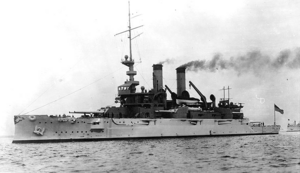Mississippi-class battleship

USS Mississippi
|
|
| Class overview | |
|---|---|
| Name: | Mississippi class |
| Operators: | |
| Preceded by: | Connecticut class |
| Succeeded by: | South Carolina class |
| In commission: |
|
| Planned: | 2 |
| Completed: | 2 |
| Lost: | 2 |
| General characteristics | |
| Type: | Pre-dreadnought battleship |
| Displacement: | 13,000 long tons (13,209 t) |
| Length: | 382 ft (116 m) |
| Beam: | 77 ft (23 m) |
| Draft: | 24 ft 7 in (7.49 m) |
| Installed power: |
|
| Propulsion: |
|
| Speed: | 17 kn (31 km/h; 20 mph) |
| Complement: | 744 officers and men |
| Armament: |
|
The Mississippi class of battleships comprised two ships which were authorized in the 1903 naval budget: Mississippi and Idaho; these were named for the 20th and 43rd states, respectively. These were the last predreadnought battleships to be designed for the United States Navy, but not the last to be built, because one more ship of a prior design was completed later under the 1904 naval budget. While the quality and technology of the weaponry and armor were first-rate, these ships included a variety of main, intermediate, secondary, and tertiary gun sizes in a predreadnought configuration which became obsolete before the ships were completed.
The first several years of the 20th century were a period of confusion and transition in US naval strategy, tactics, and ship design. The Mississippi class, along with the preceding Connecticut class, were designed based on lessons learned in the Spanish–American War, but while they were under construction, the Russo-Japanese War, war games, and experimentation demonstrated new priorities and concepts which would influence future designs. This was also a period where rapid development of techniques and training in the use of large guns made the inclusion of rapid-fire intermediate and secondary weapons unnecessary. Future US designs would reduce the confusing array of guns sizes in predreadnought battleships and rely on one gun size for the main armament, the "all-big-gun" concept, along with many small guns of a uniform caliber to combat small vessels in close proximity.
The Mississippi-class ships were smaller than the several preceding classes of US battleships. They were designed in an attempt to reduce the rapid growth in the size and cost of U.S. battleships. Also, a theory existed among influential naval leaders, including Dewey and Mahan, that many small battleships could be strategically useful, as were small ships of the line in the 18th and 19th centuries. In essence, the Mississippi-class ships were smaller versions of the preceding Connecticut class with virtually the same armament and armor, but the reduction in length, engine size, and fuel capacity caused them to be slow and short-ranged. Other design compromises caused them to perform poorly in terms of steering, stability, and sea keeping.
...
Wikipedia
